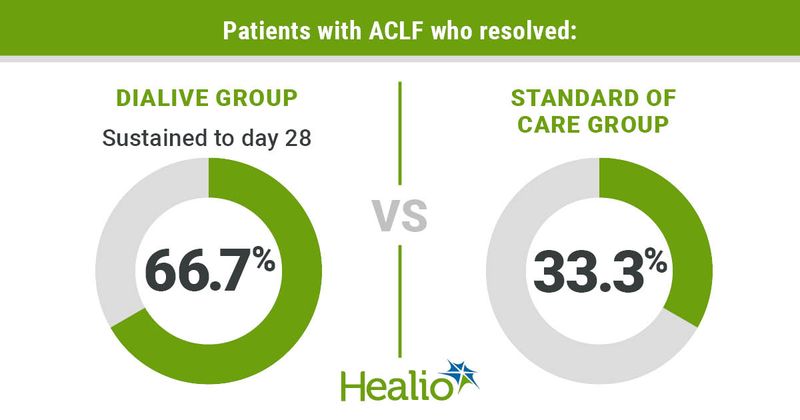Novel liver dialysis device shows promise in treating liver failure
A novel liver dialysis device that rids the body of dysfunctional albumin and replaces it with fresh albumin significantly improved survival rates among patients with acute-on-chronic liver failure, according to a presenter at The International Liver Congress.
“What we saw was that the patients treated with Dialive, two-thirds of them achieved complete resolution of ACLF – restoration to their baseline liver illness – and significant improvement in other extrahepatic non-liver organ function, especially the brain function, which is assessed on the basis of liver encephalopathy,” Banwari Agarwal, MD, of the Royal Free Hospital in the U.K. said during a press conference. Though the main endpoint of this study was safety, Agarwal and colleagues also reported on initial efficacy. This resolution of ACLF then translated into ongoing improvement as well as survival at 28 days.

Thirty-two patients with ACLF grades 1 to 3a and alcoholic cirrhosis received either Dialive (Yaqrit; n = 17) or standard of care (n = 15); 30 were included in the evaluation. In the safety study, patients had to undergo at least one session.
Agarwal reported that four patients died in the Dialive group, with the first two deaths spurring a change in protocol due to hypotension. After those complications, Dialive was only administered in the ICU setting with regular monitoring. Three patients in the standard of care group died due to progressive liver failure. There were serious AEs seen in 64.7% of the Dialive group and 53.3% in the standard of care group.
In looking at the European Foundation for the Study of Chronic Liver Failure (CLIF) organ failure score, the Dialive group showed significant improvement in the liver (P = .045) and brain (P < .001) subscores while the standard of care group showed a deterioration of its lung subscore (P = .002). Overall, the result was a significant overall treatment effect in CLIF organ failure score (P = .045 at day 10 and P = .023 at day 14).
More patients in the Dialive group reached ACLF stage 0 than in the standard of care group (66.7% vs. 33.3%; logrank P = .0357) and did so 2.8 times faster (Wald test P = .059). The same percentages of patients showed ACLF-free survival at day 28.
“Kaplan Meier curve for the time to resolution of the ACLF showed that two-thirds of the patients in the Dialive arm and one-third in the SOC arm achieved resolution by day 14. In the Dialive arm, a quarter of these patients achieved resolution by day 2,” Agarwal said in his presentation. “This ACLF resolution persisted and it translated into survival benefit, which was significantly better in the Dialive arm compared to the SOC arm.”
The CLIF-C ACLF score for the Dialive group was –5.4 less than the standard of care group (P = .064) while the MELD score was lower in Dialive at both days 5 (P = .049) and 10 (P = .028).
“Dialive is safe. Dialive significantly improves organ function, particularly liver and brain. It significantly reduces CLIF organ failure score, ACLF score and MELD score. It leads to significantly faster and in greater proportion of patients and a sustained resolution of ACLF, which translates to significantly greater survival,” Agarwal said. “The data, I propose, justifies the start of late-stage clinical trials.”

